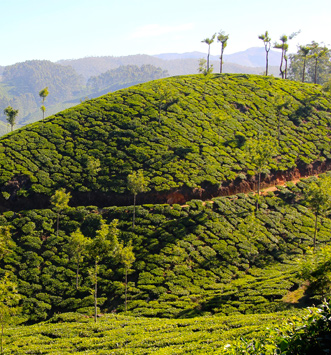
To preserve their flavor, tea leaves are not washed. Pesticide residues and other chemicals therefore remain on the tea leaves and end up in your cup, more so in loose tea than in bags. Organic tea cultivation is a guarantee for healthy nutrition and a commitment to environmental respect, plantations, and producers.
Tea leaf production, organic and non-organic, worldwide
The aroma and flavor of tea lie in the terroir, altitude, climate, type of leaf selected, manufacturing and plantation quality.
Cultivation in tea gardens
From the camellia family, the tea plant thrives in a warm and humid climate with good sunlight exposure. In tea gardens, tall trees filter sunlight and balance soil ecology. Altitude, which can reach up to 2,500 m in tropical regions, improves tea quality, sometimes at the expense of yield. Sloping terrain promotes water drainage and plant irrigation.
The tea tree is cut to a height of 1 m to facilitate largely manual and artisanal harvesting. Harvesting takes place several times a year and involves pinching the buds to collect the pekoe and picking young leaves (1 to 3 after the bud), which are more flavor-rich.
Tea leaf production in China and worldwide
The first teas were cultivated from wild tea plants. The oldest plantations are still operating in China, in the Yunnan region. They approach organic cultivation, even if they don't have the certification.
The largest producing countries are India, China, Japan and Sri Lanka. A journey through the world's plantations takes you on a discovery of flavors and colors: black teas (including Darjeeling and Ceylon tea), green teas, white teas, Assam, oolong or rooibos. Each has its own benefits. In 2020, there were four tea plantations in metropolitan France and on Reunion Island.
Plantations facing the challenge of organic tea cultivation
The goal of organic tea cultivation is to create plantations aligned with sustainable development and an ecological approach that doesn't pollute the soil, air, and water.
Quality production for organic tea leaves
In terraced tea gardens, an ecosystem is recreated by associating plants with other vegetation. Biodiversity protects and limits the use of chemicals. It contributes to fertilizer composition (provided notably by animal farming), pest control, and fighting soil erosion.
Organic tea cultivation therefore requires more work for three times less production and a higher final price. A large workforce is essential for digging, preparing compost, controlling weeds, countering diseases, and applying natural fertilizers. Green tea producers in Japan have largely opted for this sustainable approach.
Organic agricultural products serving economic development
Organic tea cultivation is governed by regulated charters. The AB label in France and the Euro-leaf for Europe guarantee the organic production of natural tea leaves, respecting the environment and working conditions of various stakeholders. From plantation to packaging, all imported teas must comply with organic rules.
In some regions of the world, organic farming is a strategy for local economic development and poverty reduction. Combined with fair trade, it contributes to improving producers' lifestyles.